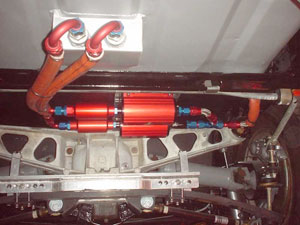 Those who choose or are forced to run a carburetor are turning to expensive, custom-built models for better performance. Often the custom shop will advise a fuel pump upgrade, suggesting a fuel pump rated to support as much as 4-6 times engine horsepower. The reason given is the effect acceleration has on filling the float bowl, driving the standing fuel back against the pump, raising head pressure, killing volume and preventing flow from starting. Seldom questioned is the static, stop-and-go nature of the system itself.
Those who choose or are forced to run a carburetor are turning to expensive, custom-built models for better performance. Often the custom shop will advise a fuel pump upgrade, suggesting a fuel pump rated to support as much as 4-6 times engine horsepower. The reason given is the effect acceleration has on filling the float bowl, driving the standing fuel back against the pump, raising head pressure, killing volume and preventing flow from starting. Seldom questioned is the static, stop-and-go nature of the system itself.
Some manufacturers, such as Aeromotive, address this problem at the source, combining high efficiency EFI style fuel pumps that deliver volume at pressure with dynamic, return style regulators designed for use with carburetors. The fuel system’s first priority is to keep the floats from running low enough to uncover the main jet, running the engine out of fuel. Traditional, static systems do a fair job of this. The second, more difficult priority is keeping the fuel level optimum in the bowl. It may not seem significant but the weight of fuel above the main jet does impact fuel flow through it, and therefore the air/fuel ratio of the engine under load.
The sophisticated carburetor racer knows the float bowl must always be as full as possible. This is critical if engine tune is to be held across the rpm band, achieving peak performance throughout the race. An area of special focus for drag cars is the first 1-200 feet after launching. Here the typical static fuel system struggles because it must start flow up the line against the G-force developed during this time. Fuel injectors depend on perfect fuel pump and regulator performance, 100% of the time. If fuel volume or pressure varies, so does the planned fuel flow through the injector. Carburetor fuel delivery is sensitive to fuel level in the bowl in much the same fashion. EFI performance requires a dynamic, flowing fuel system. A strong case is developing that carburetors need this type of system as well. Carbureted or EFI, a dynamic, return style fuel system creates a column of flowing fuel, all the way to the engine, that combats the effect of G-force.
Some high performance fuel pumps are much better equipped to handle the momentary high pressure generated by a hard leaving drag car, while maintaining critical flow volume. (You only need examine Aeromotive’s fuel pump flow-to-horsepower recommendations to see this.) Ultimately, combining a performance pump and return regulator into a dynamic fuel system significantly improves average float level, fueling the bowls more quickly and consistently. The bottom line is the finish line and getting there first with a more constant air/fuel ratio across the rpm band and more predictable power all the way down.
Tech Tip courtesy of Aeromotive.













